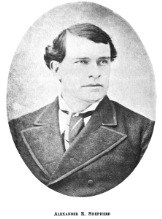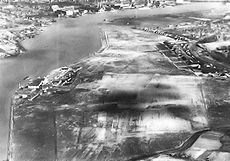|
Postbellum Era, 1866-20th Century The end of the Civil War saw major changes to the area. The Freedmen's Bureau purchased the Barry Farm to the north of St. Elizabeths Hospital and divided the land into 1 acre plots. While the area remained farm land these plots were sold to former slaves and within two years 500 families owned property. The Government disassembled the cavalry depot and returned the Giesborough land to George Washington Young. Young's attempt to sell his buildings and property were unsuccessful and after his death in 1867 the deeds went to his heirs, who slowly sold off the property. Even though the area was still very much rural a river resort, called Buena Vista, was established at Giesborough point. Ft. Carroll was transferred over to the Signal Corps. Ft. Greble was dismantled and it materials, excluding the armament, sold at auction. Downtown went through major changes as well. The city was in shambles, while the population doubled in size from 1860-1865 the infrastructure had not kept up. In 1871 Pierre L'Enfant's plan was just that, a plan, and many politicians wanted to move the Nation's Capital west. The Organic Act of 1871 repealed the individual charters of Georgetown and the City of Washington to combine them with the surrounding Washington County, creating a new charter. This was the first step towards a municipal governorship for the entire territory. 
The U.S. National Archives and Records Administration How did Shepherd Parkway get its name? While not the first Governor of Washington, Alexander Robey Shepherd was the second and most notable. Shepherd was a native Washingtonian, a Civil War veteran and a wealthy businessman, who made his money in the plumbing and gas fitting industry. As the Governor he implemented many new city improvements, including paving roads and creating a sewage system. Shepherd Parkway is perhaps named after Shepherd himself who encouraged the Baltimore and Ohio Railroad Company to extend their tracks through the Giesborough land track south and cut over the Potomac River, eventually meeting up with the City of Alexandria. 
Library of Congress 20th Century Building on Alexander Shepherd's vision, Senator James McMillian too saw the need for improvements in the city. The McMillian Plan was created to develop a system of parks in the District, including a parkway connecting the former ring of forts. So on April 11, 1927, the National Capital Parks and Planning Commission acquired Shepherd Parkway as the first property for the Fort Drive. Unfortunately, the stock market crashed and the Great Depression set in before the plan was enacted. In 1933, New Deal legislation transferred control of the land to the National Park Service. Although much of the land was purchased for the parkway, the roadway was never constructed. During the Second World War the parks were used for anti-aircraft artillery and barracks for soldiers. Today Shepherd Parkway is 205 acres of mature trees along the same ridge that once was used to secure the Nation's Capital. |
Last updated: August 31, 2017
